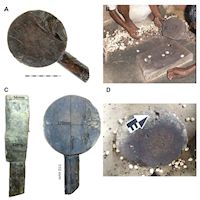

Here, we draw on ethnographic analogies citing traditional methods of E. ferox exploitation in the water bodies of northern Bihar, India, where planned sequential procedures and decision-making strategies are employed by local communities in collecting and processing E. ferox nuts (Jha et al. 1991; 2003; Jha and Barat 2003; Ahmad and Singh 2003; Goswami 2003; Khan and Halim 2003; Mishra et al. 2003; Singh 2003; Jain et al. 2010; Jain et al. 2011; Mandal et al. 2010; Singh and Singh 2011). The procedures adopted in Bihar imply an excellent knowledge of the environment and seasonality in relation to the plants' life cycle (Jha et al. 1991) (Figure 4). Important to note here is the fact that the prickles/spines on mature fruits make them very difficult to harvest with bare hands. Once the mature fruits burst, the seeds float near the leaves and then sink to the base of the pond, from where they are collected. Thus, a structured sequential process has been devised for gathering and processing the nuts, which has been discussed in the literature (Jha et al. 1991; 2003; Ahmad and Singh 2003; Mishra et al. 2003; Singh 2003; Mandal et al. 2010) and documented as part of this study (see Figures 5–8).


Based on these sources of information, we note that gathering is carried out by adult males assisted by a few adolescent boys, with a division of activities that is related to age and/or experience. The process can be summarised as follows: 1) the equipment required (bamboo collection baskets of various types) is organised; 2) bamboo poles fixed to the base of the pond serve as guides to demarcate spaces selected for underwater gathering of the nuts and are shifted as collection proceeds across the water body; 3) adults repeatedly dive underwater to collect nuts that have sunk to the pond bed, at the base of the plant; 4) the nuts are scooped into bamboo baskets (sieves); 5) in larger ponds the nuts are scooped into a large cane basket and given a preliminary cleaning underwater by repeated rotation; 6) an adolescent (inexperienced in diving) floats on the water surface with the aid of pitchers or jerry cans and employs a sieve to collect stray nuts that float to the surface; 7) the nuts brought to the shore are cleaned by trampling to remove roots, plant matter and associated molluscs (Jha et al. 1991; 2003; Ahmad and Singh 2003; Mishra et al. 2003; Singh 2003; Mandal et al. 2010). Children actively participate in gathering molluscs, crabs and other plants that are associated with the E. ferox roots and are washed up on the shore during the gathering and cleaning procedure.



Processing the nuts in the village comprises size sorting the nuts using a set of sieves, several stages of sun-drying and roasting on a wood fire and lastly popping, which results in the final nutritious product (Jha et al. 1991; 2003; Figures 7–9). The procedure of popping E. ferox seeds is widely used in Bihar and involves drying followed by at least two cycles of roasting the nuts. The nuts are then placed on a wooden anvil (around 60–70cm in diameter) and struck with a wooden mallet-like hammer (around 17–27cm in diameter) (Figures 7–8). These tools are purpose-built and are carved from the heartwood of Dalbergia sisoo, Acacia lenticularis and Shorea robusta (Jha et al. 2003) (Figures 7–8). Popping is a process whereby superheated vapour is created within the conditioned nut by heating the moisture contained within, following which the pressure is suddenly released, resulting in expansion of the volume of the kernel. Popping the E. ferox seeds by traditional methods increases the concentration of micronutrients per unit weight.
A distinct gender-based division of labour is observed. Activities within the pond/lake are male dominated, while those involving drying, cleaning, roasting and popping the seeds are largely the preserve of women, aided by children and elderly men.
It has been mentioned that the prickles/spines on the outer surface of mature fruits makes them difficult to harvest with bare hands, a problem resolved in the study region by collection after the fruits burst and sink to the bed of the pond. In Bangladesh, however, this species is harvested using boats and long-handled curved knives in order to cut the pedicle underwater (Khan and Halim 2003) and the pulpy aril and seeds are eaten, while the endosperm of the seeds is consumed raw or roasted (Khan and Halim 2003). In parts of north-east India, such as Assam, the edible seeds are eaten raw or in rare cases processed further (Goswami 2003, 34). In Manipur, the leaf petioles and seeds are eaten raw or boiled (Singh 2003, 10–11). Elsewhere in this state, the tender leaves, seed aril and fruit skin are also consumed after removal of the prickles by fire or otherwise, as is the mature leaf petiole after removal of the spines (Singh 2003, 11). It is also noted that the seeds are eaten raw after roasting in the sand and dehusking (as quoted in Singh 2003, 11). In several regions here, ripe seeds may also be eaten raw (Jain et al. 2010, 64; Jain et al. 2011) or used in a range of traditional food preparations for dietary or medicinal purposes. Others (Singh and Singh 2011) note that the immature fruits are consumed after boiling while the ripe ones are eaten fresh. In all cases, attention is paid to seasonality in harvesting parts of the plant (Jain et al. 2010, 66).